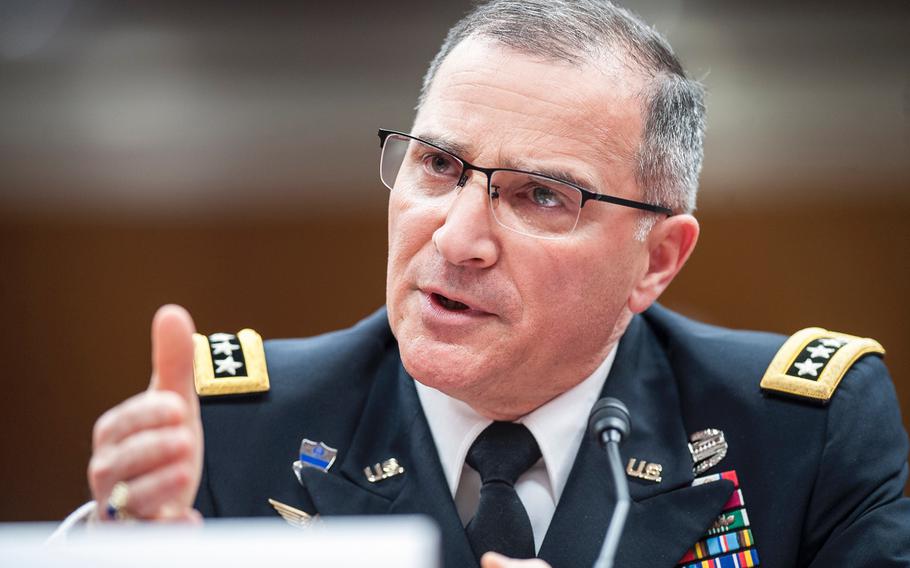
Army Gen. Curtis Scaparrotti, commander of European Command, testifies before the Senate appropriations subcommittee on Military Construction and Veterans Affairs and Related Agencies, during a hearing on Tuesday, May 2, 2017, on Capitol Hill in Washington. (Carlos Bongioanni/Stars and Stripes)
The top U.S. commander in Europe tasked with countering Russian aggression told lawmakers Tuesday that he envisions the need for an additional combat brigade and support troops in his theater of operations.
Army Gen. Curtis M. Scaparrotti, leader of U.S. European Command and NATO’s Supreme Allied Commander, told a Senate appropriations subcommittee hearing that the success of the European Reassurance Initiative rests on long-term investment and commitments, including ramped up numbers of U.S. troops, equipment and facilities to house and store them.
Only two combat brigades are permanently positioned in Europe: the 2nd Cavalry Regiment in Germany and the 173rd Airborne in Italy, roughly one-sixth of 60,000 U.S. troops stationed on the continent.
There is also a rotational armored brigade of 4,000 soldiers deployed in Europe with an additional 1,750 from an aviation brigade, but more forces, including increased armor and infantry, are needed to mirror Russia’s military composition on their western flank, Scaparrotti said.
“Russia’s posture is not a light force. It’s a heavy force,” the general said, describing the need for additional engineers, aviation and fire support personnel to strengthen the U.S. force.
However, it was unclear whether the additional unit described by Scaparrotti would be stationed permanently in Europe. A spokesman for the command could not be reached for comment Tuesday. During Scaparrotti’s confirmation hearing in April 2016, he said he favored a permanent armored brigade in Europe, and he told the Senate in March that he might need forces that range from combat air squadrons to carrier strike groups in the region.
The European Reassurance Initiative, a multibillion dollar Pentagon plan to deter Russian aggression and reassure allies in the region, has seen the training deployment of Air Force F-35As in recent weeks, coupled with ongoing training operations between the Army’s 3rd Armored Brigade, 4th Infantry Division and NATO countries.
The 3rd Brigade, based at Fort Carson in Colorado, is the first rotational armor unit in Europe, with battalions fanned out across the region. The 2nd Armored Brigade, 1st Infantry Division, based at Fort Riley in Kansas, will relieve that unit in the fall, the Army announced last week.
At the hearing, Scaparrotti emphasized the need for “stable, predictable” funding in multiyear commitments to match the long-term strategy in the region. The initiative is now funded year to year, with $3.4 billion allotted in fiscal year 2017.
Long-term budget proposals are used to position troops and boost modernization of equipment and facilities, but they are also closely watched by NATO allies and Russia as signals of commitment by Washington to keep troops and equipment in the region, Scaparrotti said.
Funding is vital to a litany of construction and equipment deployment and storage, he said, including $220 million received for the Army to preposition war machines such as tanks and artillery pieces in Poland, along with enhancing anti-submarine warfare capabilities to counter Russia’s strategic linchpin in the Arctic region.
Scaparrotti said increased funding would also help modernize decades-old hospital facilities in Landstuhl, Germany, which are used as waypoints for troops critically wounded in combat in Afghanistan, Syria and Iraq.
Improving the facilities is the highest priority project, followed by the consolidation of intelligence operations from European Command, NATO and the European Union at a base in southern England, which will allow the command to shutter other sites and save $74 million annually, he said.
Scaparrotti also echoed President Donald Trump’s calls for NATO partners to invest in some capabilities, particularly resources needed to move troops and equipment to the battlefield such as rail and fuel-storage facilities, which have declined since the Cold War ended more than 25 years ago.
“We need to be able to move with some agility,” he said.
Lawmakers acknowledged concerns over the Trump administration’s vacancies at the State Department, including the assistant secretary of state for European and Eurasian affairs. The blunting of diplomatic power is a concern for Scaparrotti, he said, given Russia’s view of using the entirety of government to consolidate power.
“We always want diplomacy to take the lead,” he said, voicing support for a stronger political strategy in the region.
Diplomacy is also vital as European Command reconsiders agreements to close existing sites. Nearly 60 sites have been returned to host nations since 2013, with 15 remaining, Scaparrotti said.
The services have identified at least two sites worth retaining, he said, now that the strategic environment has changed since those agreements were made and the services might need additional facilities to house troops and equipment.
“Five or six years ago, we weren’t concerned about being ready [to fight] today,” Scaparrotti said. “That has changed.”
horton.alex@stripes.com Twitter: @AlexHortonTX